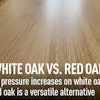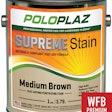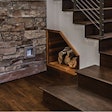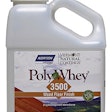As I travel around the country speaking to contractors at shows, everyone seems concerned about the changes occurring in the Northeast regarding oil-modified urethane.
It's all about the "O." The ozone, that is, or O3 . Ozone in the upper atmosphere is our friend, blocking harmful UV rays from reaching the earth. In the lower atmosphere it is a caustic molecule that can damage lung tissue and plants.
What's that got to do with your favorite polyurethane? Plenty. The EPA established a commission called the OTC (Ozone Transport Commission) whose job it is to reduce the amount of ozonecausing emissions released into the atmosphere. About 5 percent of all ozone-causing VOCs come from maintenance coatings and solvents. When a state suffers too many high-ozone days, the government asks the state to enact legislation to reduce the amount of ozone-causing VOCs in finishes and paints. That's the motivation behind the change.
Low-VOC polyurethanes are still polyurethanes, but there is an important difference. Approximately 35 percent of the VOC-containing mineral spirits that cause ozone in the lower atmosphere have to be removed and replaced with a VOC-compliant solvent. Just removing the offending solvent would make the finish thick, like molasses. There are a few VOC-exempt solvents that could be used, but some of them are so volatile they would make the polyurethane flammable. The poly would dry more quickly, but it would be much more dangerous to contractors. Other solvents are faster-evaporating than mineral spirits, but they do not make the finish flammable. Most manufacturers are taking the nonflammable route to reduce noncompliant VOC solvents.
No contractor likes a change in his favorite finish, but the changes are being made for very good reasons, and you can still get excellent results with the VOCcompliant finishes. Here are a few things you may notice:
• VOC-exempt solvents smell different from mineral spirits.
• Because VOC-exempt solvents evaporate faster, open time is reduced, so VOC-compliant polyurethanes need to be applied more quickly. Rollers and T-bars are recommended. You may find it difficult to achieve the same level of success coating large areas using a lambswool applicator or a brush.
• The time span from finish set-up until the finish can be buffed is slightly longer. You should always let the finish dry overnight before buffing. As always, polyurethane should be screened thoroughly between coats. Polyurethanes are mechanical bonders, and the scratching of the screen provides a gripping surface for the new coat.
Here are a few common questions I hear about the new low-VOC poly:
1. Can I just dump the mineral spirits back in and make it as good as old? No. Because the solvent has already been replaced, adding back mineral spirits will thin the product to a water-like consistency, which will dilute your solids. Also, please remember, it is illegal to adulterate the finish to make it non-VOC-compliant.
2. Is the new product compatible with my old poly? Yes, it's still poly. You can put VOC-compliant poly under or over standard poly.
3. Can I clean my tools the same way? You can still clean up the same way as you did with standard poly.
4. Because it smells different from the old product, is it worse for my health? Most likely not, but you should always obtain a material safety data sheet (MSDS) on your new finish to see if there are different requirements for safety.
5. What about quarts? The law allows you to purchase quarts of your old standard poly. It's called a homeowner exemption. Interpretations of the law differ on how legal it is to combine the quarts during the application. This rule will be sorted out when someone gets caught dumping 20 quarts of standard poly into a 5-gallon pail.
6. Why can I still get my old poly? The law allows distributors to sell remaining stock produced in 2004. Some manufacturers made huge amounts of finish in 2004 to delay their transition to the new standards.
7. When will these changes affect me? If you live in New York, Pennsylvania, New Jersey, Maryland, Delaware, the District of Columbia or northern Virginia, they are affecting you already. Other states may adopt the new restrictions in the near future. Each state chooses whether and when to enact these restrictions. OTC members include Connecticut, Delaware, the District of Columbia, Maine, Maryland, Massachusetts, New Hampshire, New Jersey, New York, Pennsylvania, Rhode Island, Vermont and Virginia.
It is difficult to say when the rest of the country will adopt the new restrictions, but I hope this clears up some of the misconceptions in the industry about the new rules and new finishes.
































